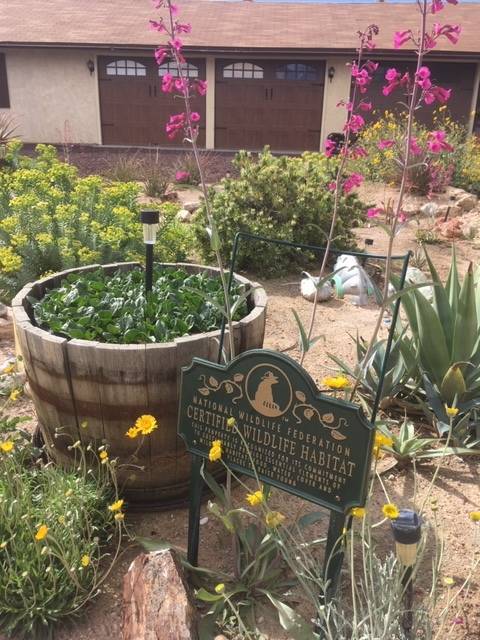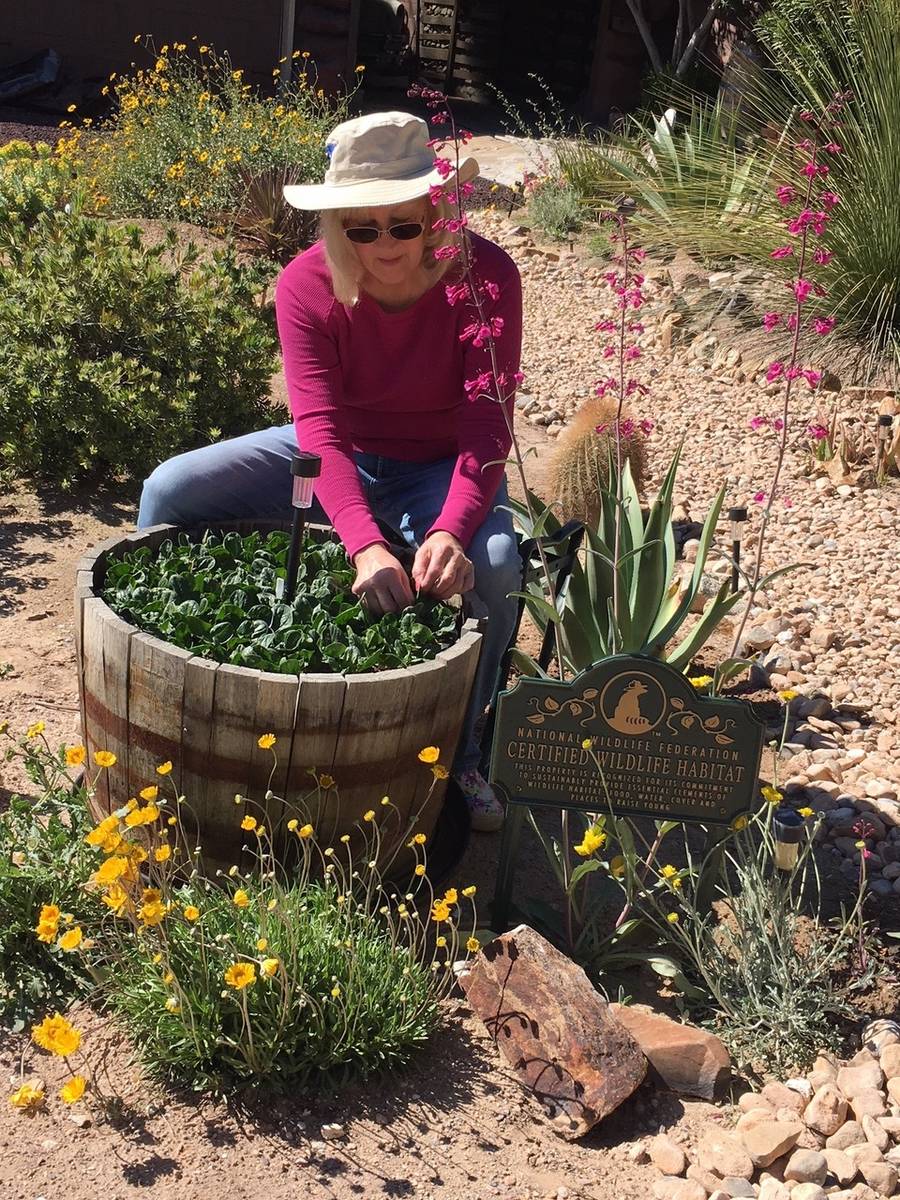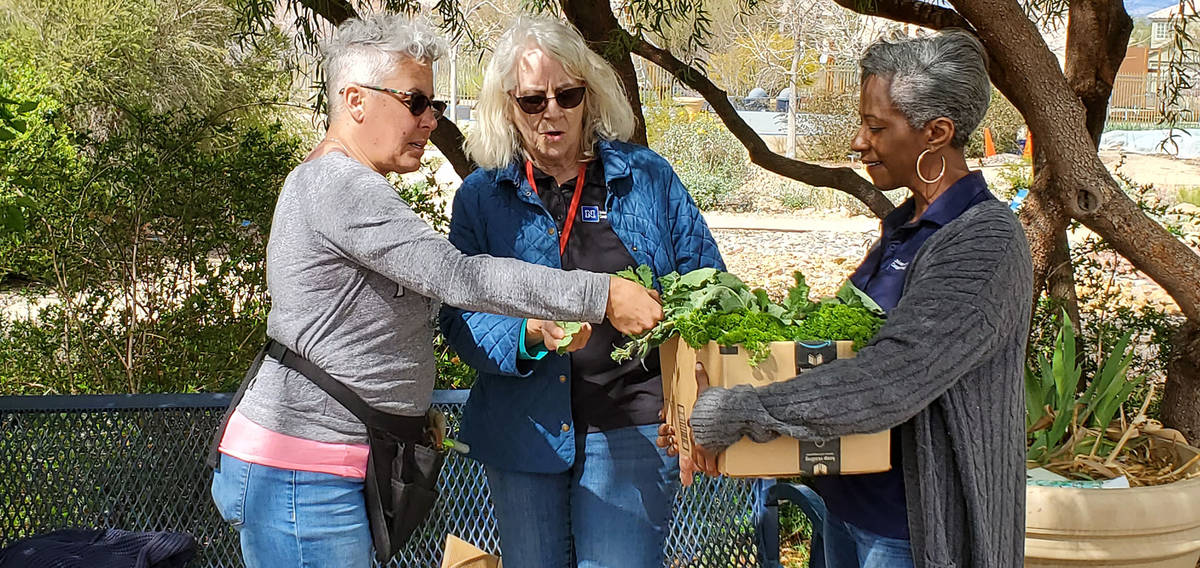Soil and seasons are the most important factors in plant growth
It took Gail Brandys three tries to grow a gopher plant in her Spring Valley yard. The first two plants, aka Euphorbia rigida and native to Southern Nevada, died.
For a self-proclaimed plant-a-holic, such failure was devastating.
Only when Brandys took a gardening class at the University of Nevada Cooperative Extension did the longtime home planter discover what went wrong.
The expert there told Brandys her gopher plant needed native soil. Shake off the rich, black dirt from the nursery container, the expert said, and put the Euphorbia rigida in the whiter, rockier ground of the Las Vegas Valley.
“That did it,” said Brandys, who has been a successful container and small-space gardener in Las Vegas for the past 10 years or so. “You put native plants in topsoil, you kill ’em.”
Like so many newcomers to Southern Nevada, Brandys initially found it challenging to grow any of her favorite vegetables and flowers in a region so dominated by intense heat and sunshine.
But her gopher-growing experience revealed one of two roadblocks those with green thumbs face in a search for more prosperous plant production in the valley. Assuming water is easily accessible, home planting is more about soil and seasons.
Getting the soil right and growing in the proper season seem obvious. But Southern Nevada is a different world for home gardeners who first cultivated in the darker soil and the four distinct seasons of the East and Midwest.
Southern Nevada has highly alkaline soil — many vegetables and flowers require more acidic soil — and intense summer heat can simply scorch healthy plants.
So it was a bit of trial and error for Brandys, who has been an avid gardener for most of her adult life, first in her native New Jersey and then for more than 30 years in the Chicago suburb of Hinsdale, Illinois.
“Back there, it’s throw seeds at the soil and jump back,” says Brandys, 66.
But after becoming a master gardener through classes at the cooperative extension two years ago, Brandys better understands the challenges of Southern Nevada horticulture.
“It’s doable. You just have to know the tricks,” Brandys said. “I’ve been here 10 years and I’m still learning.”
Soil and seasons
While Southern Nevada’s alkaline soil lacks nutrients and is less than ideal for many plants favored by home gardeners, like tomatoes, peppers and roses, it’s ideal for native plants. So going native can be a simple and satisfying alternative, Brandys said.
“Try to appreciate the native plants more than some of things you used to grow where you lived before,” she said. A visit to any nursery will yield things like gopher plants, species of verbena and agave, dwarf bottlebrush and soap aloe.
As for those plants more favored in the East and Midwest, the first step is to amend the soil; lower the pH, making it more acidic.
“If you have the energy, the money and the time, you can grow anything here,” said Angela O’Callaghan, a social horticulture specialist with the cooperative extension in Las Vegas.
It doesn’t have to be expensive or overly time-consuming, but it can take a bit of energy.
“The best way to control the alkalinity is to compost,” O’Callaghan said. “Food scraps, grass clippings and leaves added to soil boost nutrients and bring down alkalinity.”
Peat and sulfur products also can reduce alkalinity, but O’Callaghan likes the idea of using items from the home.
“Less expensive and easy,” she said.
Also, because of the high mineral content of valley water, even soil brought in from nurseries and home centers can absorb salt and climb in pH over time, she said. So compost to lower pH and add nutrients, and remix the soil when finished with seasonal planting. When planting, be sure the soil is somewhat loose and airy.
“Good soil is made up of one-half solids, one-quarter water and one-quarter air,” said O’Callaghan, who along with other horticulture experts and volunteers maintain an expansive botanical garden at the cooperative’s offices at Paradise Road and the 215 Beltway. “Roots need oxygen, too.”
Soil temperature defines seasons
What about the growing seasons?
“The first thing is to get July and August out of your heads,” O’Callaghan said — too hot, too dry, too much sun. Southern Nevada’s two hottest months “are brutal for growing and planting.” (Except for melons and pumpkins, but that’s another story.)
The region’s seasons can be defined as warm and cool, O’Callaghan said.
The warm season “is when nighttime soil temperatures are consistently at 50 degrees and above.” That’s often March through June.
The cool season is when soil at night works out to be between “40 and 50 degrees,” mainly from September through February.
The cooperative extension has a thorough seasonal planting guide, and several such guides often are available through nurseries.
“Fruits and veggies, peppers, tomatoes, berries, beans, those are warm-season plants,” Brandys said. “Those leafy greens are better in the cool season.”
Containers and raised beds
With fig trees, peach trees, leafy lettuces, root vegetables, herbs and more, the extension’s botanical garden on Paradise Road is proof that almost anything can grow in the valley. Its nearly 3.5 acres offer hundreds of examples of Mother Nature rising up against valley obstacles.
So is Brandys’ yard in Spring Valley, where she has more than 100 plants on about one-third of an acre — fruit trees, vegetables and ornamentals — many in small containers and raised beds with drip irrigation. There are six varieties of tomatoes, asparagus, grapes, beans and even spinach, which she’ll harvest through April.
Her tips are basic and include lots of research, plus tricks like lining terra cotta pots (they suck water from the soil) with smaller plastic ones and placement, making sure the plant is exposed to the proper mix of sun and shade.
She’s found that some of her onetime favorites — hostas and peonies, for example — are pretty much impossible to grow in the valley.
As for tomatoes, a homeowner favorite, they need 30 percent shade, which can be accomplished in the hottest of seasons with shade cloth, available at nurseries. For fruit throughout the season, try indeterminate varieties; determinate varieties provide fruit for about two weeks or so and then start to wither.
So often, however, success stories come back to seasons and soil.
“When it comes down to growing what you grew elsewhere or native plants, it’s about enriching the soil versus low maintenance,” Brandys said.
Resource rich
The University of Nevada Cooperative Extension is a terrific resource for gardeners.
Classes, including those for kids, and growing advice are available by visiting the website, extension.unr.edu.
The extension offices statewide are closed during the coronavirus shutdown, but information on gardening classes, online resources and horticulture can be obtained by emailing Angela O'Callaghan, a social horticultural specialist with the extension, at ocallaghana@unr.edu.
Other informative websites:
■ Nevada Division of Forestry, forestry.nv.gov/ndf-state-forest-nurseries/planting-information-resources
■ Clark County, clarkcountynv.gov/comprehensive-planning/eco-county/Documents/SNRPC_Regional_PlantList.pdf
■ Southern Nevada Water Authority, snwa.com/assets/pdf/water-smart-plant-list.pdf.































